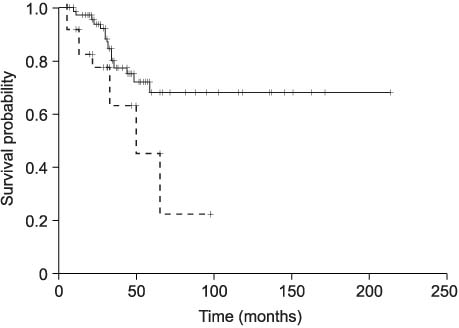Korean J Urol.
2006 Feb;47(2):131-136. 10.4111/kju.2006.47.2.131.
The Clinical Significance of Hydronephrosis and the Tumor Diameter in Ureteral Transitional Cell Carcinoma
- Affiliations
-
- 1Department of Urology, Urological Science Institute, Yonsei University College of Medicine, Seoul, Korea. youngd74@yumc.yonsei.ac.kr
- 2Department of Pathology, Yonsei University College of Medicine, Seoul, Korea.
- KMID: 2294190
- DOI: http://doi.org/10.4111/kju.2006.47.2.131
Abstract
-
PURPOSE: We evaluated the clinical significance of the grade of hydronephrosis and the tumor diameter in ureteral transitional cell carcinoma (TCCa).
MATERIALS AND METHODS
From 1986 to 2003, the medical records of 101 patients who had been surgically treated and diagnosed with ureteral TCCa were retrospectively reviewed with regard to the clinicopathological characteristics, including the grade of hydronephrosis and the tumor diameter.
RESULTS
The grade of hydronephrosis was grade 0 in 11 patients, grade I/II in 34 patients and grade III/IV in 56 patients, respectively. The tumor diameter measured on the transverse section of computed tomography was <1.5 cm in 39 patients, 1.5 cm < or = < 2.5 cm in 36 patients and > or = 2.5 cm in 26 patients, respectively. Of the 56 patients with grade III/IV hydronephrosis, invasive tumor was found in 49 patients (87.5%) and grade III tumor was found in 48 patients (85.7%). Of the 62 patients with a tumor diameter 1.5 cm or greater, invasive tumor was found in 50 patients (80.6%) and grade III tumor was found in 52 patients (83.9%). The grade of hydronephrosis and the tumor diameter correlated with the T stage and tumor grade (p<.001). In addition, the grade of hydronephrosis (p=0.041) and the tumor diameter (p=0.007) have a significant influence on the disease-specific survival.
CONCLUSIONS
The grade of hydronephrosis and the tumor diameter correlate with the pathologic T stage and tumor grade. Thus, radical surgery is required for the patients with severe hydronephrosis or a large tumor diameter.
MeSH Terms
Figure
Reference
-
1. Tawfiek ER, Bagley DH. Upper-tract transitional cell carcinoma. Urology. 1997. 50:321–329.2. Hall MC, Womack S, Sagalowsky AI, Carmody T, Erickstad MD, Roehrborn CG. Prognostic factors, recurrence, and survival in transitional cell carcinoma of the upper urinary tract: a 30-year experience in 252 patients. Urology. 1998. 52:594–601.3. Ministry of Health and Welfare. 1998 Annual Report of the Korea Central Cancer Registry.4. Ministry of Health and Welfare. 1999 Annual Report of the Korea Central Cancer Registry.5. Ministry of Health and Welfare. 2000 Annual Report of the Korea Central Cancer Registry.6. Ministry of Health and Welfare. 2001 Annual Report of the Korea Central Cancer Registry.7. Ministry of Health and Welfare. 2002 Annual Report of the Korea Central Cancer Registry.8. Cozad SC, Smalley SR, Austenfeld M, Noble M, Jennings S, Raymond R. Transitional cell carcinoma of the renal pelvis or ureter: patterns of failure. Urology. 1995. 46:796–800.9. Corrado F, Ferri C, Mannini D, Corrado G, Bertoni F, Bacchini P, et al. Transitional cell carcinoma of the upper urinary tract: evaluation of prognostic factors by histopathology and flow cytometric analysis. J Urol. 1991. 145:1159–1163.10. Ozsahin M, Zouhair A, Villa S, Storme G, Chauvet B, Taussky D, et al. Prognostic factors in urothelial renal pelvis and ureter tumours: a multicentre Rare Cancer Network study. Eur J Cancer. 1999. 35:738–743.11. Miyake H, Hara I, Gohji K, Arakawa S, Kamidono S. The significance of lymphadenectomy in transitional cell carcinoma of the upper urinary tract. Br J Urol. 1998. 82:494–498.12. Park SC, Hong BH, Kim CS, Ahn HJ. The impact of tumor location on prognosis of transitional cell carcinoma of the upper urinary tract. J Urol. 2004. 171:621–625.13. Planz B, George R, Adam G, Jakse G, Planz K. Computed tomography for detection and staging of transitional cell carcinoma of the upper urinary tract. Eur Urol. 1995. 27:146–150.14. Scolieri MJ, Paik ML, Brown SL, Resnick MI. Limitations of computed tomography in the preoperative staging of upper tract urothelial carcinoma. Urology. 2000. 56:930–934.15. McCarron JP, Mills C, Vaughn ED Jr. Tumors of the renal pelvis and ureter: current concepts and management. Semin Urol. 1983. 1:75–81.16. Chung HJ, Chen KK, Lin AT, Chang YH, Wu HH, Hsu TH, et al. Is renal function at the tumor side a prognostic factor in ureteral transitional cell carcinoma? Urol Int. 1997. 59:166–169.17. Murphy DM, Zincke H, Furlow WL. Primary grade 1 transitional cell carcinoma of the renal pelvis and ureter. J Urol. 1980. 123:629–631.18. Zoretic S, Gonzales J. Primary carcinoma of ureters. Urology. 1983. 21:354–356.19. Anderstrom C, Johansson SL, Pettersson S, Wahlqvist L. Carcinoma of the ureter: a clinicopathologic study of 49 cases. J Urol. 1989. 142:280–283.20. Millan-Rodriguez F, Palou J, de la Torre-Holguera P, Vayreda-Martija JM, Villavicencio-Mavrich H, Vicente-Rodriguez J. Conventional CT signs in staging transitional cell tumors of the upper urinary tract. Eur Urol. 1999. 35:318–322.21. Milestone B, Friedman AC, Seidmon EJ, Radecki PD, Lev-Toaff AS, Caroline DF. Staging of ureteral transitional cell carcinoma by CT and MRI. Urology. 1990. 36:346–349.22. Atasoy C, Yagci C, Fitoz S, Sancak T, Akyar G, Akyar S. Cross-sectional imaging in ureter tumors: findings and staging accuracy of various modalities. Clin Imaging. 2001. 25:197–202.
- Full Text Links
- Actions
-
Cited
- CITED
-
- Close
- Share
- Similar articles
-
- Nested Variant of Transitional Cell Carcinoma with Hydronephrosis
- A Case of Transitional Cell Carcinoma of the Remnant Ureter
- A Clinical Observation on Malignant Tumors of Renal Pelvis and Ureter
- Spontaneous Renal Subcapsular Hemorrhage with Hydroureteronephrosis due to Transitional Cell Carcinoma at Ureterovesical Junction
- A Case Report of Primary Ureteral Tumor combined with Giant Hydronephrosis



